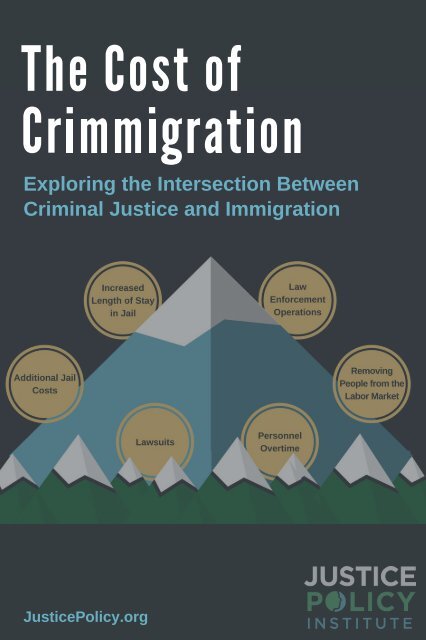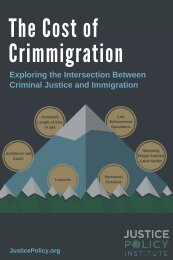The Cost of Crimmigration
The Cost of Crimmigration - Exploring the Intersection Between Criminal Justice and Immigration
The Cost of Crimmigration - Exploring the Intersection Between Criminal Justice and Immigration
You also want an ePaper? Increase the reach of your titles
YUMPU automatically turns print PDFs into web optimized ePapers that Google loves.
<strong>The</strong> <strong>Cost</strong> <strong>of</strong><br />
Exploring the Intersection Between<br />
<strong>Crimmigration</strong><br />
Criminal Justice and Immigration<br />
JusticePolicy.org
ABOUT<br />
According to the Immigrant Legal Resource Center, every<br />
county in the United States some involvement with the<br />
Department <strong>of</strong> Homeland Security’s (DHS) immigration<br />
enforcement efforts. However, the cost to taxpayers when<br />
local governments “partner” with DHS goes well beyond<br />
what few dollars a community might get from the federal<br />
government and <strong>of</strong>ten exceeds expected criminal justice<br />
expenses. <strong>Crimmigration</strong> has led to significant increases in<br />
local spending on incarceration, an additional burden on city<br />
and county taxpayers. Communities lose valuable workers<br />
who are needed in vital parts <strong>of</strong> the local economy, which<br />
lose tax revenue when immigrants are ensnared in the<br />
system for minor immigration violations. Cities and counties<br />
also face potential lawsuits due to complications resulting<br />
from enforcing Immigration and Customs Enforcement<br />
(ICE) policies. All these costs are paid for by local taxpayers,<br />
with little to no reimbursement by the federal government.
TABLE OF CONTENTS<br />
What is <strong>Crimmigration</strong>?<br />
Impact on Local Communities<br />
<strong>Cost</strong> <strong>of</strong> <strong>Crimmigration</strong><br />
<strong>Cost</strong> <strong>of</strong> Non-citizen Detention<br />
Public Safety<br />
Immigration Enforcement Programs<br />
Legal Liability<br />
Punishment <strong>of</strong> Sanctuary Cities<br />
Social <strong>Cost</strong>s to Society<br />
Lost Tax Revenue
What is<br />
<strong>Crimmigration</strong><br />
<strong>Crimmigration</strong><br />
A term used by the policy reform community to refer to the intersection<br />
between criminal law and immigration law, where state and local criminal<br />
justice systems have begun to enforce federal immigration <strong>of</strong>fenses and<br />
expand the categories <strong>of</strong> criminal infractions that can incarcerate and<br />
apprehend both authorized and unauthorized non-citizens. <strong>Crimmigration</strong><br />
policies are the newest iteration <strong>of</strong> America’s mass incarceration problem:<br />
even minor citations can make authorized immigrants detainable and<br />
deportable, costing jurisdictions millions <strong>of</strong> dollars annually.<br />
Delegation <strong>of</strong> Immigration Authority Program – or<br />
287(g)<br />
A collaboration between the Department <strong>of</strong> Homeland Security and a city or<br />
county that deputizes law enforcement <strong>of</strong>ficers to enforce federal immigration<br />
laws, on behalf <strong>of</strong> ICE. <strong>The</strong> local <strong>of</strong>ficers have the authority to identify,<br />
process, charge, and detain people believed to be violating immigration law.<br />
State Criminal Alien Assistance Program (SCAAP)<br />
A program that potentially reimburses state and local governments for the cost<br />
<strong>of</strong> holding non-citizens. In recent years, SCAAP reimbursements covered less<br />
than a quarter <strong>of</strong> the total costs, while funding has continued to drop and is<br />
eliminated in President Trump’s proposed budget.
Impact on<br />
Local<br />
Governments<br />
Cities and counties can become involved in federal immigration<br />
enforcement by establishing a partnership with the Department <strong>of</strong> Homeland<br />
Security under section 287(g) <strong>of</strong> the Immigration Reform and Immigration<br />
Responsibility Act (IRIRA). Involvement in 287(g) programs deputizes local<br />
law enforcement <strong>of</strong>ficers (i.e. local police or Sheriffs) to perform certain<br />
Immigration and Customs Enforcement (ICE) functions.<br />
While cities and counties receive a modest amount <strong>of</strong> funding for training<br />
and to assume federal immigration enforcement roles, these federal dollars do<br />
not cover a significant portion <strong>of</strong> the costs associated with immigration<br />
enforcement. <strong>The</strong> remaining, and <strong>of</strong>ten substantial, amount is then borne by<br />
local taxpayers who, in return, see little to no public safety benefit. Under the<br />
current Administration, these partnerships are expected to grow, as are their far-<br />
reaching impacts.<br />
Click to learn more about communities that have already felt the negative<br />
consequences <strong>of</strong> crimmigration involvement
<strong>of</strong> <strong>Crimmigration</strong><br />
<strong>Cost</strong><br />
Although general law enforcement expenditures<br />
cover a wide spectrum, the United States spends<br />
a staggering amount on immigration enforcement,<br />
with the burden falling heavily on key states.<br />
Nearly 1/3 <strong>of</strong> Immigration Law<br />
Enforcement <strong>Cost</strong>s go to the<br />
top 5 states<br />
Top 5 State Immigration Law<br />
Enforcement <strong>Cost</strong>s<br />
1. California - $1,197,000,000<br />
2. New York - $403,200,000<br />
3. Texas - $366,100,000<br />
4. Florida - $320,700,000<br />
5. Illinois - $238,100,000<br />
Total <strong>Cost</strong> = $3,894,100,000
<strong>Cost</strong> <strong>of</strong> Non-citizen<br />
Detention<br />
One <strong>of</strong> the major costs related to immigration<br />
enforcement is non-citizen detention. States and<br />
counties must find places to hold non-citizens,<br />
<strong>of</strong>ten for extended periods <strong>of</strong> time.<br />
Over 2/3 <strong>of</strong> Non-citizen Detention<br />
<strong>Cost</strong>s are borne by only 5 states<br />
Top 5 State Non-citizen<br />
Detention <strong>Cost</strong>s<br />
1. California - $721,600,000<br />
2. New York - $174,400,000<br />
3. Arizona - $154,800,000<br />
4. Texas - $149,600,000<br />
5. Florida - $114,400,000<br />
Total <strong>Cost</strong> = $1,857,400,000
50<br />
40<br />
30<br />
20<br />
10<br />
0<br />
Safety<br />
Public<br />
While non-citizens commit crime at lower rates<br />
than natural-born citizens, they face<br />
disproportionate arrest and sentencing rates at<br />
the local, state, and federal levels.<br />
Recent rhetoric about the<br />
relationship between criminal<br />
Percentage <strong>of</strong> Noncitizens<br />
in Total Incarcerated<br />
Population<br />
activity and immigrants is false.<br />
Research shows that non-citizens<br />
commit far less crime than native-<br />
born citizens.<br />
Non-citizens Incarcerated at State and<br />
Federal Levels = 88,248<br />
Federal Criminal Offenses <strong>of</strong><br />
Undocumented Non-citizens<br />
99% <strong>of</strong> the people locked up in the<br />
federal system for immigration<br />
violations were arrested for drug<br />
or immigration <strong>of</strong>fenses. Less than<br />
1% are arrested for<br />
murder/manslaughter.
X<br />
X<br />
X<br />
X<br />
X<br />
X<br />
Immigration<br />
Programs<br />
Enforcement<br />
As the burden <strong>of</strong> immigration enforcement falls on<br />
local counties and cities, government programs<br />
promise aid that covers only a fraction <strong>of</strong> the cost.<br />
Completely<br />
Voluntary?<br />
Fully Funded?<br />
Immigration Detainer<br />
Secure Communities<br />
Criminal Alien Program<br />
287(g) Program<br />
State and Local Detention<br />
Contacts with ICE
written request to a law enforcement<br />
a<br />
to hold non-citizens for an additional 48 hours, in order to provide ICE<br />
agency<br />
meaningful opportunity to decide whether to take an individual into federal<br />
a<br />
for potential removal.<br />
custody<br />
Liability<br />
Counties face lawsuits as they hold non-citizens<br />
in detention centers well beyond the 48-hour<br />
Legal<br />
ICE Detainer period.<br />
ICE Detainer (or ICE Hold):<br />
$40,000<br />
<strong>Cost</strong> that Jefferson County, CO was<br />
subjected to during a lawsuit after<br />
holding a man in jail for 47 days on an<br />
ICE Hold.<br />
$724,000<br />
Proposed settlement cost to San Juan<br />
County, NM for illegal holds.<br />
$35,000<br />
<strong>Cost</strong> to Spokane County, WA to settle<br />
with a man who was wrongfully held<br />
without bail for 20 days due to an<br />
ICE Hold.
Sanctuary Cities: a place designed to limit cooperation with involvement<br />
Punishment <strong>of</strong><br />
Cities<br />
Sanctuary<br />
<strong>The</strong> current Administration threatens to take away<br />
funding to cities that do not cooperate with federal<br />
immigration enforcement.<br />
in federal immigration enforcement through formal and informal policies.<br />
$454/person<br />
<strong>The</strong> average amount <strong>of</strong> lost federal funding<br />
for a family <strong>of</strong> four residing in a sanctuary<br />
city.<br />
$1.7 bilion<br />
Federal funding at risk for Santa Clara,<br />
$3.6 bilion<br />
CA, 1/3 <strong>of</strong> their budget.<br />
<strong>The</strong> amount that Chicago could lose in federal<br />
funding for programs such as affordable<br />
housing and education.<br />
$500m<br />
<strong>The</strong> amount Mayor de Blasio estimates<br />
New York City taxpayers will to pay to<br />
make up for lost federal funding.
<strong>Cost</strong> to Society<br />
Social<br />
Immigration enforcement results in many noncitizens<br />
living in fear <strong>of</strong> detention and deportation<br />
after any interaction with police.<br />
Davidson County, TN<br />
participated in the 287(g) program. After seeing<br />
these consequences, they withdrew from the program:<br />
42%<br />
Percentage <strong>of</strong> Latinxs in Davidson<br />
County who said they knew <strong>of</strong> a crime<br />
<strong>of</strong> police involvement.<br />
54%<br />
that has not been reported due to fear<br />
Percentage <strong>of</strong> Latinxs who admitted to not<br />
calling the police, fearing racial pr<strong>of</strong>iling<br />
73%<br />
related to immigration issues.<br />
People in Davidson County, who<br />
reported feeling increased apprehension<br />
about police cooperation.<br />
85%<br />
<strong>The</strong> amount <strong>of</strong> Davidson County non-<br />
citizen arrests that are misdemeanors, a<br />
disproportionate impact <strong>of</strong> 287(g).
Tax Revenue<br />
Lost<br />
Along with the costs associated with enforcing<br />
immigration policies, the economy will lose<br />
valuable assets provided by non-citizens.<br />
$11.74B<br />
<strong>The</strong> amount <strong>of</strong> sales, property, and state<br />
tax per year paid by undocumented<br />
immigrants.<br />
8 million<br />
<strong>The</strong> number <strong>of</strong> non-citizens contributing to<br />
the workforce.<br />
$551.6B<br />
<strong>The</strong> amount that the country would lose in<br />
economic activity if all unauthorized<br />
immigrants were removed.
ABOUT THE ORGANIZATION<br />
Justice Policy Institute (JPI) is a national nonpr<strong>of</strong>it that is dedicate<br />
to reducing the use <strong>of</strong> incarceration and the justice system by<br />
promoting fair and effective policies. JPI staff includes Paul<br />
Ashton, Jeremy Kittredge, Olivia Martinez, Marc Schindler, Jamille<br />
White, Keith Wallington, and Jason Ziedenberg.<br />
WRITTEN BY<br />
Jeremy Kittredge<br />
RESEARCH INTERNS<br />
Amanda Pierson, Mahalia Thomas, Chelsea Voron<strong>of</strong>f<br />
DESIGNED BY<br />
Mahalia Thomas<br />
This flipbook would not have been possible without the generous<br />
support <strong>of</strong> the Open Society Foundation and independent<br />
donors to JPI.










